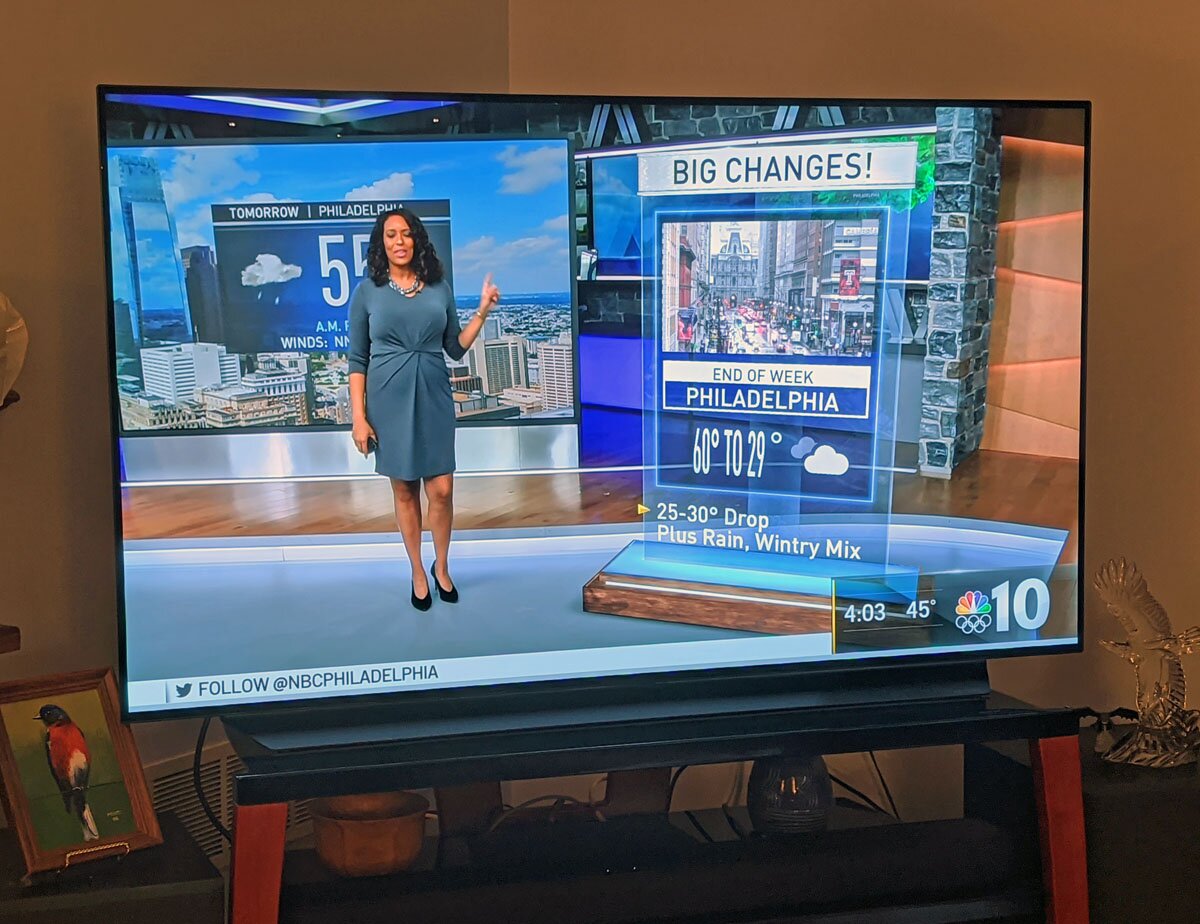After years of telling people to wait for the two weeks leading up to the Super Bowl for the best deals on a new television, I decided it was time to follow my own advice and upgrade from the 47-inch LG Full HD LCD TV in my family room that dated back to 2011. (This model originally came with passive 3D glasses, which I never used. Remember 3D?)

I started looking around for deals on 55-inch sets the week before the 49ers – Chiefs game. It helped to set a budget, which resulted in me checking out some “premium” model LCD sets. One constraint was that I needed to use an existing glass-top TV stand with shelves, picked up as a bargain closeout from my local HH Gregg store when the chain closed.
That meant the distance between the TV’s supporting legs couldn’t exceed 34 inches, which put me in a tight spot right away. Why? Because most TV brands now use two outrigger legs, and not pedestals. Among the brands I was perusing, only LG offered the option of a pedestal support in that particular screen size.
What’s more, it had to be one of the company’s NanoCell UHD models. NanoCell is LG’s version of a high dynamic range LCD TV, using a full array backlight and a color notch filter for yellow to improve color accuracy and mixing. It’s not as bright as a quantum dot set…but then again, none of those would fit on my existing stand.
Sometimes I “secret shop” at my nearby Best Buy to see just how much the salespeople actually know about their products. But first I had to find one – there was nobody in the TV department when I first wandered in. After finally locating a clerk, I asked to borrow a tape measure and proceeded to check out the leg spacing all of the featured models from Samsung, LG, Sony, TCL, and Vizio. Again, only the LG LCD (and OLED) TVs would work for me. (Most normal people would pay more attention to picture quality.)
My wife has been a long-time member of Consumers Union, so I logged into the Consumer Reports Web site to see what they thought of the NanoCell models. Indeed, these sets got very high marks…but not as high as those given to Sony and LG OLED UHDTVs. I did have to admit that the picture and color quality on LG OLEDs was better (no surprise) and the horizontal viewing angle was wider (again, no surprise).
We have a specialty home theater retailer nearby that’s been doing business for 40 years and is highly regarded. So, I drove down the street to World Wide Stereo to get a closer look at both the NanoCell and OLED models in a living room setting. Both sets performed well with a range of SDR and HDR 4K content, but what turned me off was the “blooming” behind white titles and graphics on dark backgrounds on the Nano 9 set, something that’s not all that unusual with local area dimming on LCDs.
The catch was the price differential, which amounted to a premium of $500 for the LG OLED55C9P over the LG 55SM9000PUA Nano 9. However, LG had come up with a steep discount ($700) on the OLED model for their Super Bowl promotion – and it would cost me the same whether I bought it at the specialty store or Best Buy.
 My new LG OLED55C9 In Use – click for higher resolution
My new LG OLED55C9 In Use – click for higher resolution
In the end, I finally decided to put more cash on the table and go with the C9, one of LG’s highest-rated models in recent years. I did, however, go cheap on an LG soundbar at Best Buy (it’s a family room, after all!), only to wind up returning it the next day because the power cables for the main sound bar and wireless subwoofer were missing. (BB insisted it was NOT an open box item, and the Store Returns associate asked why I even needed power cables if the box said it was a “wireless” soundbar system. Yes, she did go there.)
So – back to World Wide Stereo, this time to walk out with a Yamaha 3.1 wireless soundbar system that DID have all of the cables and actually sounds very good – much better than I expected, particularly with its simulated spatial surround mode. It’s easy to see why more people are opting for sound bars over discrete 5.1 and 7.1 audio systems, especially with wireless subwoofer connections over Bluetooth.
In the end, I wound up spending more than I had budgeted, but in retrospect, the display limitations of an LCD TV would have nagged at me constantly. (I used to have a Panasonic plasma TV, so I’m spoiled.) And the picture quality of OLEDs is just spectacular, with no viewing angle limitations.
Plus, I got a bunch of bells and whistles I’ll probably never use (Disney+, Apple Music) and some I will (Netflix, Hulu Live, Amazon Prime). And being a big proponent of free, over-the-air TV, I have nearly 70 minor channels of ABC, CBS, NBC, PBS, Fox, CW, and other programming (HD and SD) at my fingertips.
Don’t get me wrong – the LG Nano 9 series sets are strong performers, although they won’t hit the peak brightness levels of quantum dot sets. As an alternative to expensive OLEDs, they wouldn’t be a bad second choice, and I did notice they had a wider usable viewing angle than the nearby Samsung quantum dot sets, the usual advantage of IPS vs. PVA alignments. Of course, if you don’t have the leg spacing limitations I had, the sky’s the limit.
I’ll check back in nine years to let you know how it’s working out! – PP

